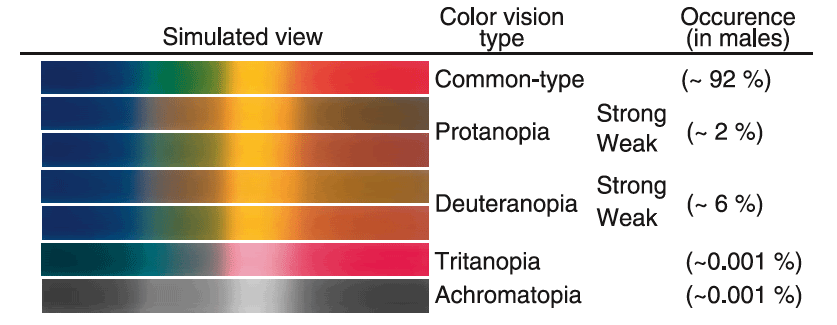Δυσχρωματοψία – Defective color vision
Ελαττωματική χρωματική όραση
Σε προηγούμενο post πήγαμε σε κινηματογράφο και αναρωτηθήκαμε αν και ο διπλανός μας θεατής έβλεπε, όπως εμείς, τα ίδια ακριβώς υπέροχα χρώματα στο φαντασμαγορικό μουσικοχορευτικό έγχρωμο έργο.

Μας πέρασε επίσης η ακραία σκέψη, μήπως έβλεπε και το μιούζικαλ όπως και το πρώτο έργο που δεν ήταν έγχρωμο, μήπως δηλαδή δεν έβλεπε καθόλου χρώματα και τα έβλεπε όλα ασπρόμαυρα. Ότι είχε αχρωματοψία.
Οι περιπτώσεις πλήρους αχρωματοψίας είναι σπάνιες και είναι ελάχιστοι όσοι πάσχουν από αυτό το πρόβλημα. Δυστυχώς όμως έχει καθιερωθεί να λέγεται «αχρωματοψία» κάθε πρόβλημα που δεν επιτρέπει σε κάποιους συνανθρώπους μας να βλέπουν τα χρώματα φυσιολογικά, όπως η πλειοψηφία των ανθρώπων.
Ο όρος αχρωματοψία λοιπόν είναι παρα- πλανητικός. Ο σωστός είναι «ελαττωματική χρωματική όραση». Άτομα που έχουν αυτό το ελάττωμα, βλέπουν μεν χρώματα αλλά συγχέουν τις αποχρώσεις που οι περισσότεροι άνθρωποι ξεχωρίζουν ευκρινώς.


Η ελαττωματική χρωματική όραση οφείλεται στην πλήρη έλλειψη ή σε μικρότερη από την κανονική ποσότητα κωνίων για την πρόσληψη συγκεκριμένου μήκους κύματος του ορατού φωτός. Μπορεί πάλι τα κωνία να έχουν έλλειψη η να περιέχουν λιγότερη ιωδοψίνη από την κανονική για την διέγερσή τους και αντίληψη του συγκεκριμένου χρώματος.
Όσοι έχουν έλλειψη κωνίων ευαίσθητων στην επίδραση της κόκκινης ακτινοβολίας καλούνται «Πρωτάνοπες». Αυτοί έχουν έλλειψη της αίσθησης του κόκκινου χρώματος.


Αυτοί που στερούνται της αίσθησης του πράσινου χρώματος καλούνται «Δευτεράνοπες».


Λιγότεροι είναι οι «Τρι(τ)άνοπες», αυτοί δηλαδή που δεν αντιλαμβάνονται το μπλε χρώμα.


Οι περισσότεροι χρωματοελαττωματικοί είναι διχρωματικοί, δηλαδή στερούνται μόνο ενός τύπου κωνίων, επομένως αντιλαμβάνονται τις δυο από τις τρεις χρωματικές ακτινοβολίες που αντιλαμβάνονται οι φυσιολογικοί τριχρωματικοί άνθρωποι.
Υπάρχουν όμως και κάποιοι που στερούνται δυο τύπους κωνίων, σπανιότερη περίπτωση των διχρωματικών, οι οποίοι αντιλαμβάνονται μόνο μια ακτινοβολία. Αυτοί καλούνται κωνιο – μονοχρωματικοί.
Ακόμα σπανιότερη είναι η περίπτωση στέρησης και των τριών τύπων κωνίων. Οι άνθρωποι αυτοί καλούνται ραβδιο – μονοχρωματικοί και είναι μάλλον οι μόνοι που τους ταιριάζει ο όρος αχρωματοψία. Αυτοί διαθέτουν μόνο ραβδία και δεν αντιλαμβάνονται καθόλου χρώματα, μόνο τη διαφορά φωτός σκότους και τις ενδιάμεσες αυτών διαβαθμίσεις.
Translated into English
Defective color vision
In a previous post we had been to cinema and wondered if the next to us viewer saw the wonderful spectacular colorful musical exactly the same as we did.
We also had the extreme thought that perhaps he saw the full of colors musical as the first project that was not colored, i.e. that he did not see any colors and everything looked to him black and white. That he was colorblind.
The cases of complete blindness are rare and are very few those people who suffer from this problem. Unfortunately, however, has been established to be called "colorblind" every problem that prevents some people to see colors normally, as the majority of people.
The term color blindness is therefore misleading. The right term should be “defective color vision”. People who have this defect, although they see colors they confuse the nuances that most people stand out prominently.
The defective color vision is due to a complete lack, or less than the normal amount of cones for the perception of a specific wavelength of visible light. It can be also due of the cone deficiency in iodopsin i.e. that cones contain less than normal amount of iodopsin needed for the stimulation and the perception of the certain color.
Those who lack cones sensitive to the effects of red radiation are called "Protanopes” and lack the sensation of red.
Those who lack the sense of green are called "Deuteranopes.
Fewer are the "tritanopes", those who do not realize the blue color.
Most people who have defective color vision are bichromatic, that means the lack of only one type of cones, so they are sensitive to the two of the three color radiations perceived normally by trichromatic humans.
But there are some who are deprived of two types of cones, a rarer case of the bichromatics, those are called momochromatics and see just one color.
There is a more rare case of people who have no cones at all and perceive only light. This is called rode – monochromatic vision and these people are probably the only ones matching to the term “colorblindness”. They have only rods and do not perceive any colors, only the difference of light and dark and the gradations in between.
admin is | Topic: Δυσχρωματοψία | Tags: None



7 Comments, Comment or Ping
Evrydiki
Πολύ ενδιαφέρον…
Θα ήταν ώραιο να βλέπαμε και περισσότερες φωτογραφίες.
15-10-10
admin
Χαίρομαι Evrydiki που βρήκες το θέμα πολύ ενδιαφέρον.
Ασφαλώς και θα ακολουθήσουν περισσότερες ανάλογες φωτογραφίες, αλλά και posts επί του θέματος.
Πάνος
17-10-10
Phlebotomy Certification
this post is very usefull thx!
12-11-10
xrumer
found your site on del.icio.us today and really liked it.. i bookmarked it and will be back to check it out some more later
26-11-10
pell grant
Valuable info. Lucky me I found your site by accident, I bookmarked it.
5-12-10
maria andros
Great work keep it coming, best blog on earth
Gordon Begolli
Hi! I love holidays, so I would like to wish you and yor friend so and Merry Christmas. I believe that next year will be very enjoying for you. Could I advise you something? I have read your post and if I could I would suggest you few intresting things or advice. Perhaps you can publish next posts reffering to this post. I would love to read next detials about it! I am sure that I come again and read more of your articles.
2-1-11
Reply to “Δυσχρωματοψία – Defective color vision”